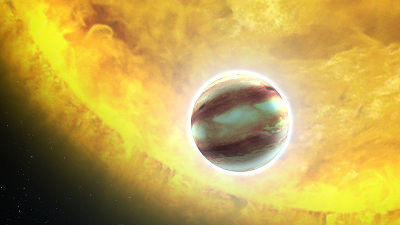``Super Earth'' in an environment close to the earth is discovered by a research team at the University of Tokyo

A space area that can maintain an appropriate distance from a fixed star and maintain a temperature where living things can survive is called a ``
[Research Results] Super Earth Discovered in the Habitable Zone - Graduate School of Arts and Sciences, The University of Tokyo
https://www.cu-tokyo.ac.jp/info/news/topics/20220907160000.html
Speculoos discovers a potentially habitable super-Earth
https://www.news.uliege.be/cms/c_16795199/en/speculoos-discovers-a-potentially-habitable-super-earth
The super earth discovered by the research team is two planets revolving around the red dwarf star `` LP 890-9 '' located 100 light years away from the solar system. In order to search for planets outside the solar system, NASA operates a satellite `` Transiting Planet Search Satellite (TESS) '' that detects the dimming of the main star when the planet passes in front of the main star (transit). In July, TESS observed that the red dwarf LP 890-9 was fading with a period of about 2.73 days, and the transit planet candidate TOI-4306.01 revolved around LP 890-9. It was made public that In order to verify whether this 'TOI-4306.01' is really a planet or not, with the Japanese astronomical observation team 'MuSCAT' participating in the TESS Follow-up Observing Program (TFOP) The Belgian astronomical observation team 'SPECULOOS' has conducted follow-up observations from August 2021.
The MuSCAT team will use the three-color simultaneous imaging camera 'MuSCAT3' installed at the Haleakala Observatory on Maui and the near-infrared radial velocity measurement device 'IRD' installed on the Subaru Telescope to achieve 'TOI' by 2021. -4306.01' is a planet. Below is a picture of 'MusCAT3' used for observation.

In addition, the following photograph is a copy of the near-infrared radial velocity measurement device 'IRD'.

The SPECULOOS team continuously observed LP 890-9, including transit times that differed from the transit times of TOI-4306.01 originally reported by TESS. As a result, in October and November 2021, we observed a fading period different from that of 'TOI-4306.01'. The MuSCAT team and the SPECULOOS team collaborated to analyze the new dimming, revealing the existence of a planet with an orbital period of 8.46 days, different from 'TOI-4306.01'.
Of the two super earths discovered, one radius is 1.32 times the radius of the earth and the other is 1.37 times. The University of Tokyo speculates that these super-Earths are rocky planets rather than gas planets. Also, as to why planets with short orbital periods of 2.73 days and 8.46 days are located in the habitable zone, the University of Tokyo found that the surface temperature of 'LP 890-9' is only about 2600 degrees (the sun is about 5500 degrees). It is said that the small size of the radius of about 15% of the sun is affecting it.
According to the University of Tokyo, the detailed environment of the discovered Super Earth is unknown at this time. Future observations are expected to reveal the composition of the atmosphere and the presence or absence of clouds.
Related Posts:
in Science, Posted by log1o_hf







